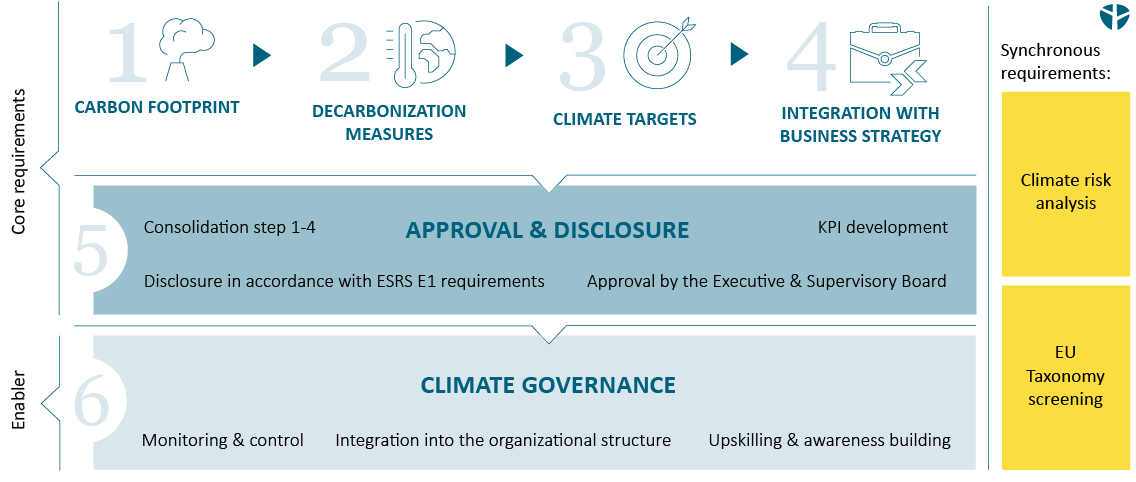FAQ
Frequently asked questions on climate transition plans
What are climate transition plans?
Climate transition plans are a crucial instrument to showcase an organization’s dedication to pursuing the 1.5-degree pathway. Climate transition plans are developed to ensure the continued relevance and profitability of a company’s business model, both to capital markets and stakeholders. It places global warming at the core of your company’s strategy, clearly illustrating its significance for businesses. This approach underscores the importance of addressing climate change in companies.
Are climate transition plans mandatory?
In addition to legal requirements, there is another aspect driving the increased demand for CTPs. Since managing and adapting to climate risks has long become a crucial criterion in investment decisions, climate transition plans also provide important answers for investors and other stakeholders.
What are climate transition risks?
Climate transition risks are financial and operational challenges faced by organizations during the transition to a low-carbon, net-zero economy. They arise as companies move away from fossil fuels and high-carbon procedures, embracing cleaner alternatives while addressing climate change impacts. The CSRD climate standard ESRS E1 calls for the disclosure of climate-related impacts, risks, and opportunities along the value chain (IRO-1).
What makes a good climate transition plan?
A good climate transition plan aligns with current scientific understanding and ensures actual emissions reduction within your company. It essentially maps out the transformation of your business and your business model. The approval processes and engagement of various stakeholders ensure that the climate transition plan is pursued and holds strategic significance within your organization. A good climate transition plan emphasizes transparent communication, implements effective emission reduction measures, and can be tracked through key performance indicators and monitoring structures. Ideally, the CTP is firmly embedded within your company’s governance structures.
What are the most important climate transition plan questions?
When working on a climate transition plan, the following questions provide some guidance:
- CCF calculation: What is my company’s impact on the climate?
- Data quality: How can I ensure the data robustness for my CCF baseline?
- Risk and opportunities: How does climate change impact my company and its business model?
- Climate action: What are the most effective decarbonization levers?
- Strategy alignment: How can I engage C-Level and decision-makers?
What is the difference between a climate strategy, a net zero strategy and a climate transition plan?
Climate strategy describes the company’s overall climate targets (emission reduction targets) and pathways to reach these targets with adequate reduction measures. A typical climate strategy covers different time horizons, with a focus on more granular elements in the near- to mid-term. Find out more about our decarbonization and climate strategy consulting services.
Net zero strategy specifically addresses the company’s long-term pathway and planned measures to reach net zero GHG emissions in a dedicated period of time (typically 2040 or 2050). According to SBTi, residual emissions of max. 10% from the base year is allowed to claim net zero, while the reduction target needs to be aligned with a 1.5° pathway. Learn more about science-based target setting.
A climate transition plan incorporates a 1.5 ° transition pathway and requires science-based climate targets as milestones for this pathway. It therefore asks for a net zero target by 2050 at the latest (net zero strategy). The CTP is essentially the implementation plan of the climate or net zero strategy, as it incorporates strategic and operative planning of embedding the climate / net zero strategy in the overall business model and financial planning, in the best case also embedding it directly in the company’s governance structures.
Can I build existing Net Zero Targets and climate strategies into a climate transition plan?
As the CTP is the implementation of climate targets and strategies, it is a well-recommended next step to think about how to bring corporate commitments on the ground and derive specific actions and initiatives. As included in its name, a climate transition plan is about transition planning, i.e. strategic preparation of the necessary transformation of the company, its business model and operating mode for a net zero future.





